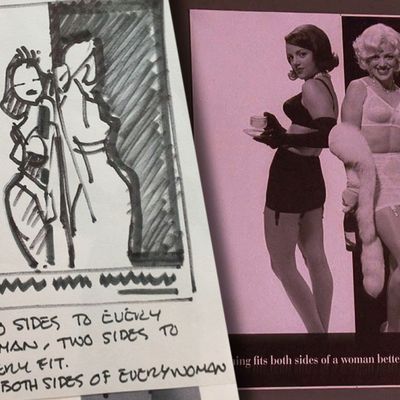
Sunday night’s episode of Mad Men featured a botched advertising pitch for Peter Pan’s Tinkerbell cookies, a campaign that involved kids writing Dear John letters to rival cookie companies — and eventually results in Johnny Mathis’s firing. It was an ancillary plotline, but over the years, ad campaigns have fueled both the central and background drama on the show. The man behind them, Mad Men co-producer Josh Weltman, meticulously executes many of the ads we’ve seen Don Draper and Peggy Olson pitch. “My job was to try to get these characters, Don and Peggy, to appear to conjure advertising,” Weltman said.
When Weiner first approached Weltman, he asked him how much had changed in advertising since the ’50s and ’60s. “After I read the pilot, I told him not a lot has changed at all,” said Weltman, whose book Seducing Strangers: How to Get People to Buy What You’re Selling, which includes a foreword by Jon Hamm, imparts his wisdom from two-plus decades in the industry.
Weltman’s artistic background was a major selling point for Weiner. “I could draw, and I had been educated the same way that art directors who were trained in the ’40s and ’50s were trained,” he said. “Matt was such a stickler for detail, he really wanted somebody on staff who could get the look and sketches that he saw in pictures of the advertising agencies he researched. He was choosing to portray the advertising process at a time when art directors and writers started working together in teams to come up with unifying picture-word concepts.”
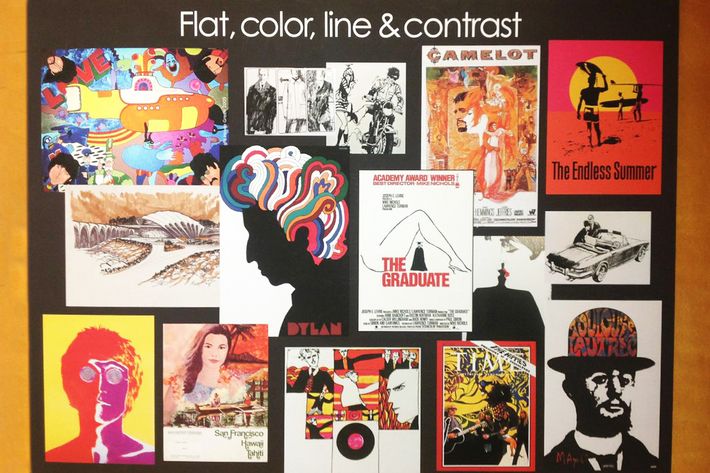
Every season, Weltman would put together a mood board of graphics, typefaces, and colors to inspire him. Weiner wouldn’t allow him to use technology to create the ads if it had not been around at the time in which the season was supposed to occur. “The first season, Matt wouldn’t let me do the comprehensive layout in marker until we showed an ad that someone found in the back of a CA magazine, showing Magic Markers were available in 1963,” he said. “If you look at the first ads that I was working on in the show, like the Right Guard ads in episode two, they’re all done in grease pencil. As soon as we found that out, I switched to markers.”
Vulture caught up with Weltman to talk about Sunday night’s Peter Pan campaign and some of the the most memorable Mad Men ads from over the years. Below, Weltman shares many of his sketches and mood boards, alongside the final products, and the stories behind them.
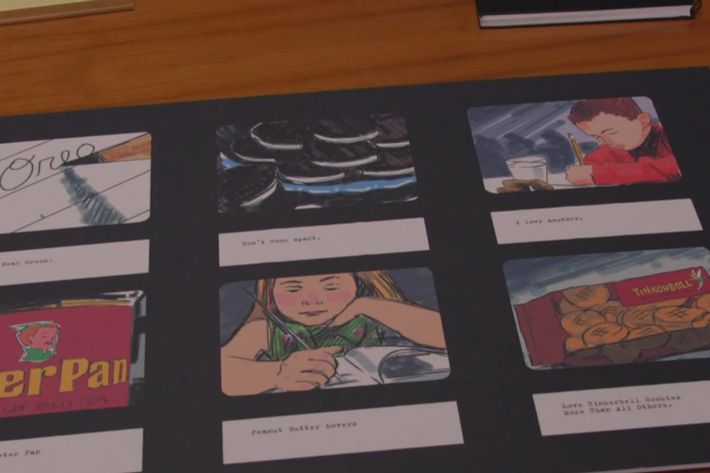
One Tink and You’re Hooked (Season 7, Episode 10)
“Matt wanted a campaign about love and loss that Don would kill, thematically, to let us know how Don is feeling. Obviously, the episode was all about love — Joan maybe finding love, and Glen confronting Betty, Don and his bit with Sally’s friend. Matt was really looking for some campaign to talk about how Don is feeling about love and loss, and I loved the children sending Dear John letters to other cookies.”
Weltman noted that the Dear John letters are meant to foreshadow Glen shipping out overseas to Vietnam. “The kids [are] acting like adults, sending these letters to the cookies. My feeling was that we had really come to an elegant solution that wove together all of those themes in a nice way. We got the love in there, we got the kids in there, we got the reverse of adulthood and childhood and everybody not quite acting the way they should. I love that [Don] just killed the whole thing when Mathis throws out, ‘One Tink and you’re hooked.’ In my notes, it said, ‘Don will kill this campaign because it requires too much math.’ It’s too complex for mothers to follow the killing of the competition.”
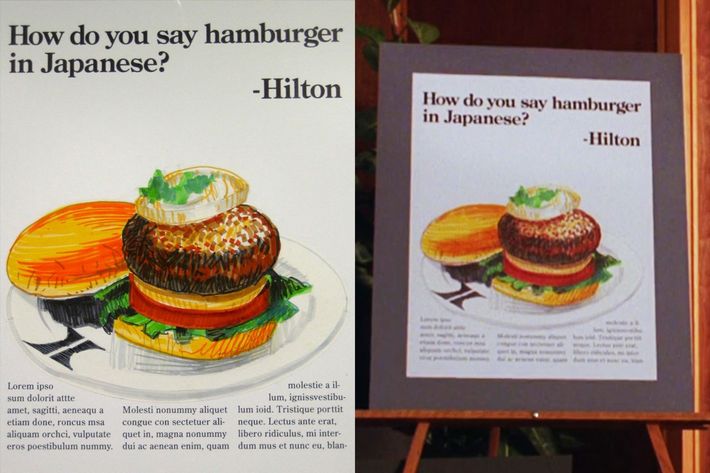
How Do You Say Hamburger in Japanese? (Season 3, Episode 9)
“Thematically, Matt was fascinated by the sort of American crusader businessman of the period, who really believed that spreading the American way around the globe was the best way to fight the Cold War, to be a great example for the country, to be what he should be as a person, as a businessman, as an American, as a patriot. Conrad Hilton was the right person to bring to tell that story. There was the story of Don adopting him as this father figure and wanting to please him, but also feeling that because they had a personal relationship. I thought the advertising had to show that Don felt comfortable enough with this client to take a risk. It was really the agency’s first foray into a modern look. It’s a very clean, very Helmut Krone, very Madison Avenue ’60s conceptual kind of thing. The most important thing, in my view, was to get that emotional moment that Matt was going for, which is, Conrad wants the moon. He sort of dresses Don down for bringing him something different than what he asked for, and Don’s character looks crushed. For him to look crushed, he had to have the goods. You totally feel the air coming out of him. To get that to happen, I felt the ads had to be really good. He could’ve played excited for anything that we put in his hands like a prop, but for it to really work and for you to feel his creative disappointment as a writer and creative director, it had to be all right. I loved that scene. I love that whole story line.”
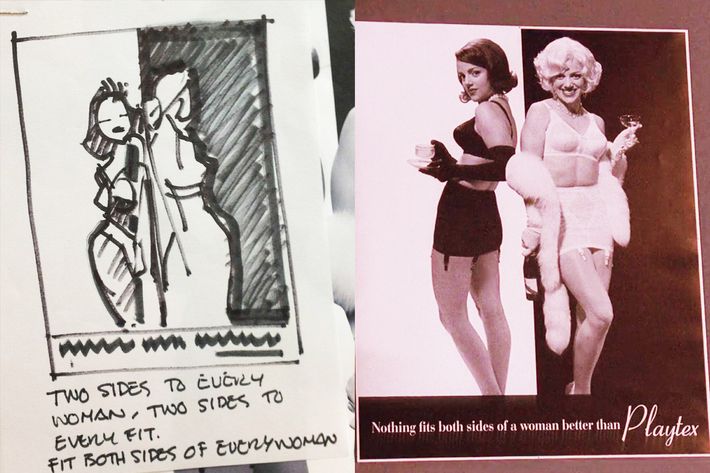
Nothing Fits Both Sides of a Woman Better Than Playtex (Season 2, Episode 6)
“The Jackie-versus-Marilyn thing began with Playtex saying, ‘We gotta get hip like Maidenform.’ They put the agency through the paces. Oftentimes it was that Matt and the writers were looking to emphasize a scene that he was talking about in the body of the show. In that one, it was that whore/Madonna idea, that to men of the period, a woman was either a Marilyn or a Jackie. That was Paul’s insight. Figuring out how to use that insight and theme in the advertising, that was really fun. I loved the solution of that, ‘Playtex fits both sides of a woman, top half, bottom half, Jackie and Marilyn.’ I liked thinking about it that way. The line felt very reminiscent of that Blackglama ad campaign, ‘What becomes a Legend most?’ It felt like a line you could run forever with different models. Devil on one side, angel on the other. It felt very period, and I liked what it did, thematically. We used an actress model to shoot the ad, we dressed her up in two different costumes. I think it worked really well to support the theme that we were talking about. Those were always my criteria: Does it support the story, does it look period, does it feel plausible? That one checked all the boxes.”
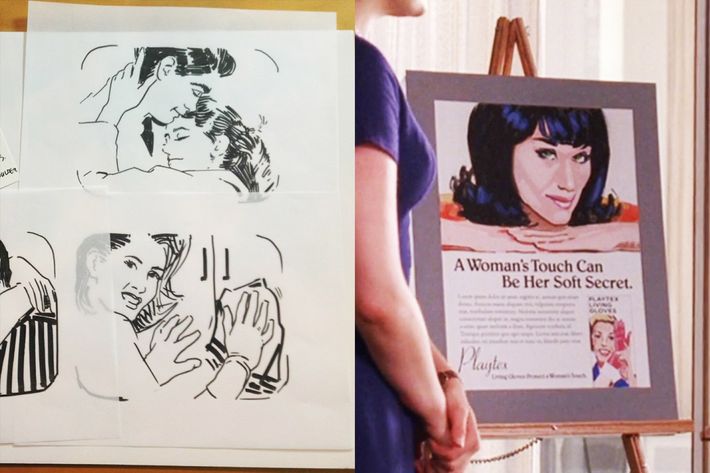
A Woman’s Touch (Season 4, Episode 11)
“’A Woman’s Touch’ is much more about Peggy’s sexual awakening and feeling confident in using her own experience to shape her advertisement. I loved seeing Peggy bring that sort of thinking to something that was so feature-oriented, which was for the gloves. We kept trying to explain that an agency’s bad advertising talks about product features, and in my experience, good advertising talks about product benefits. Protecting your skin is the feature, but protecting your touch is the benefit. I loved seeing Peggy grow to understand that.”
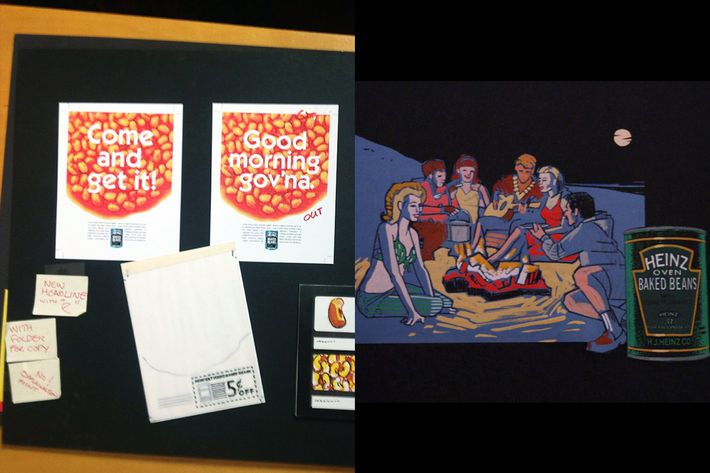
Home Is Where the Heinz Is (Season 5, Episode 7)
“Matt really wanted to talk about the idea that companies started advertising to young people. They were really worried about the younger generation, the generation that was protesting the war and rejecting their parents’ attitudes and feelings. He was fascinated by the idea that these large, Establishment companies were really worried about what would happen if the counterculture would take over. They were talking about anti-materialism and anti-consumption. If you look at the Who’s album The Who Sell Out, they were making fun of baked beans and antiperspirant. A lot of the jokes at the time were making fun of advertising. Look at the original Saturday Night Live and the Bass-O-Matic: A lot of their first sketches were just pimping advertising. It became a cultural force, and it was so ripe that companies were worried about that. That’s what Matt was going for with the baked beans. He had this middle-aged executive telling the agency to make beans cool. They put the young person, Megan, on it, and they go through all sorts of iterations on that. That was one of the first advertising story lines that actually took three or four episodes to complete. We started showing campaigns. There was a lot of politics at the Heinz company that we folded into the story. I think they went through three go-rounds of showing him work until he ended up with a campaign that he liked, which I believe was ‘Home Is Where the Heinz Is,’ with a bunch of kids in a circle on the beach.
“The hard part was that in a story, you don’t want to show the first ad campaign until you know what the last ad campaign is going to be. You want to end on the good one and start on the one that’s wrong, and you don’t know what’s wrong until you know what’s right. It became one of those things where we weren’t quite sure what the right one was. The first one was supposed to film the next day. So we were just finishing up being able to understand what the first ad campaign should be as we’re shaping the last one. It was one of those things where I’m working all night and delivering things to the set as quickly as I can so we can do that. I tell people a lot that in my real career in an advertising agency, the point of coming up with the idea was a financial payoff. But in the show, what we’re going for is an emotional payoff. It’s a little bit different. We wanted Megan to win the day, come up with a great idea that shows her ability and solves a problem for Don, and make him really appreciate her as a copywriter. We wanted to talk about the Heinz client getting a campaign that he thinks is right for the company and right for young people. There were a lot of things to weave in and out of that one.”
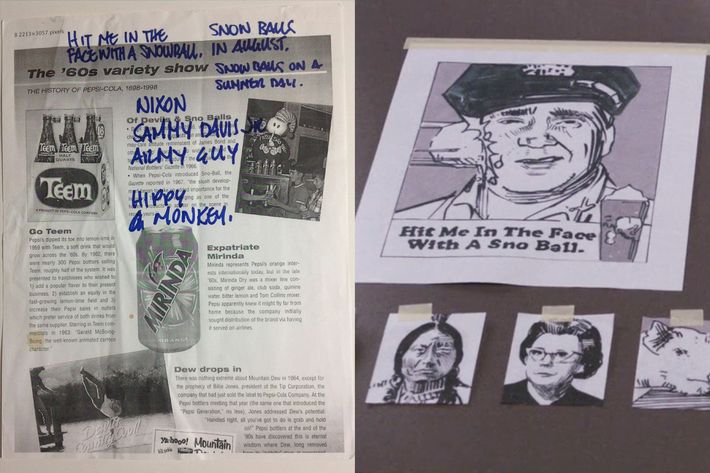
Hit Me in the Face With a Sno-Ball (Season 5, Episode 9)
“I remember when we were working on Ginsberg’s portfolio, we had talked about what Ginsberg was like, and that he was this sort of advertising savant. The ads in his book, I think the one that gets Peggy’s attention is a sporting-goods store advertising for Father’s Day, and he does these eyes that are peeking out from a column of newspaper advertising. I remember thinking that every ad I tried to create for Ginsberg’s book somehow ignored the boundaries of the ad. He was not going to be bound by the page or the specs, or the size of the advertisement. That’s who Ginsberg was: He knew no boundaries, and that was really important. Even the snow ball is coming from outside, which you could never really shoot. How are you going to shoot those speed lines coming through? Whoever threw the snowball came from outside the ad, and they’re included in the concept. That was always stuff that I was trying to think about with Ginsberg’s work. He works on the same level that advertising works on. It may not be socially or politically correct, but he is keyed into that sort of primal, childlike sensibility.”
Josh Weltman’s book Seducing Strangers: How to Get People to Buy What You’re Selling is available now.




